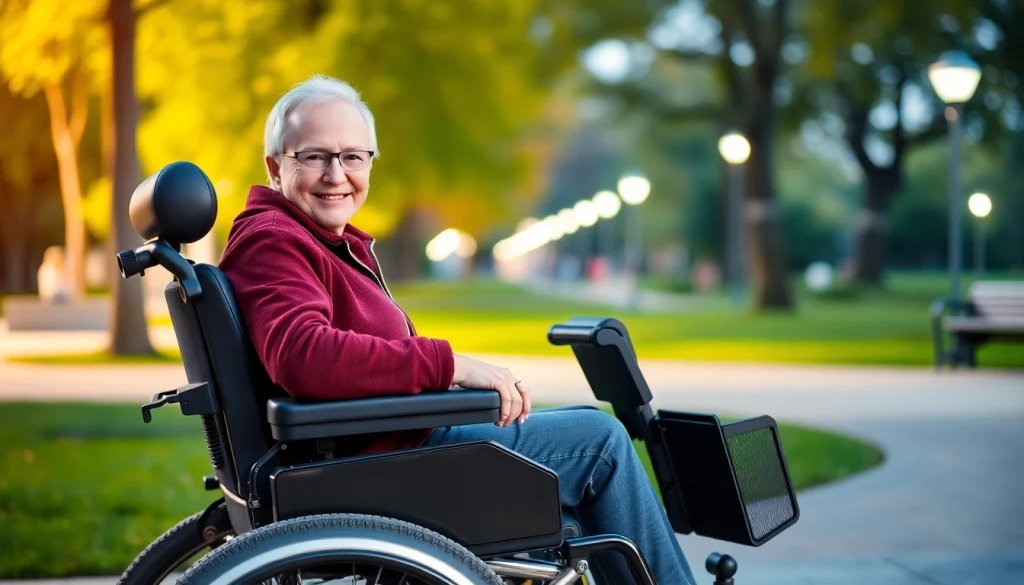
Understanding Power Wheelchairs
What is a Power Wheelchair?
A power wheelchair, often referred to as an electric wheelchair, is a mobility device that allows individuals with limited mobility to navigate their surroundings with ease. Unlike traditional manual wheelchairs, which require physical effort to propel, power wheelchairs come equipped with electric motors powered by batteries. This innovation empowers users to maintain independence and freedom of movement. Typically controlled by a joystick or similar interface, these devices are designed for both indoor and outdoor use, accommodating a wide range of lifestyles and mobility needs. For those seeking enhanced mobility solutions, understanding the mechanics of a power wheelchair can be the first step toward improving quality of life.
How Power Wheelchairs Differ from Manual Wheelchairs
Power wheelchairs are distinguished from manual wheelchairs primarily by their mode of operation. While manual wheelchairs rely on the user or an assistant to operate, power wheelchairs utilize electric power for movement. This distinction has significant implications for the user experience:
- Ease of Use: Power wheelchairs can be easily maneuvered by users with limited upper body strength, as the only requirement is the use of a joystick or control panel.
- Speed: Electric wheelchairs offer higher speeds than manual variants, significantly reducing travel time and increasing mobility efficiency.
- Terrain Navigation: Many power wheelchairs come equipped with features that allow for better handling of varied terrains—something that can be challenging with a manual chair.
- Energy and Stamina Conservation: Users do not expend physical energy to move, thus conserving their stamina for other daily activities.
Key Components of a Power Wheelchair
Understanding the key components of a power wheelchair can aid in making informed purchasing decisions. Below are crucial elements to consider:
- Motor and Drive System: Power chairs typically feature direct current (DC) motors that provide drive to the wheels. The type and power of the motor determine the speed and hill-climbing ability.
- Batteries: Most commonly, power wheelchairs use sealed lead-acid or lithium-ion batteries that vary in capacity and charging time.
- Controllers: The controller is the brain of the wheelchair. It interprets joystick movements and sends signals to the motors to facilitate movement.
- Chassis and Frame: The frame must be durable and lightweight for easy transport. Materials such as aluminum or steel are frequently used to blend strength with agility.
- Seating System: Comfort is paramount, which is why many wheelchairs include adjustable seating options that cater to individual shapes, sizes, and posture needs.
Benefits of Using a Power Wheelchair
Increased Mobility for Independence
One of the most significant advantages of power wheelchairs is the increased mobility for users, contributing profoundly to their independence. Individuals using power wheelchairs can navigate their environments more freely, from their homes to outdoor spaces, without the assistance of caregivers. This newfound independence not only enhances physical movement but also plays a crucial role in boosting confidence and self-esteem.
Case studies reveal that individuals who transitioned from manual to power wheelchairs reported significant improvements in their quality of life. This upgrade allowed them to partake in social activities, thereby reducing feelings of isolation.
Enhanced Comfort Features
Comfort is critical for anyone spending prolonged periods in a wheelchair. Power wheelchairs often come with advanced seating cushions, adjustable backrests, and ergonomic designs to accommodate long-term usage without discomfort. Features like tilt and recline functions can further enhance user comfort while providing pressure relief for vulnerable body areas. Ergonomic and adjustable designs allow users to customize their seating position, contributing to overall well-being and preventing complications such as pressure sores.
Customizable Options for Individual Needs
Power wheelchairs can be tailored to meet individual needs and preferences. Manufacturers offer a variety of options, from custom seating arrangements and joystick controls to specialized tires and other adaptive features. Users with specific medical conditions may require unique adjustments for better mobility or comfort. Consulting with healthcare professionals can guide the customization process, ensuring that the chosen wheelchair aligns with the user’s lifestyle and needs.
Choosing the Right Power Wheelchair for You
Factors to Consider: Size and Weight
When selecting a power wheelchair, size and weight are critical factors. The wheelchair should comfortably accommodate the user’s body size, ensuring adequate support and maneuverability. Additionally, consider the weight of the chair itself; a lighter model may be more convenient for transportation in vehicles and may also be easier to manually maneuver when necessary.
For those living in smaller spaces, a compact power wheelchair will be ideal, allowing for easier navigation through hallways and doorways.
Battery Life and Maintenance
Battery life is a vital aspect of a power wheelchair’s overall functionality. Users should assess how long the battery lasts on a full charge relative to their daily activities. Some models offer extended battery life, which can be particularly beneficial for outdoor use. Furthermore, regular maintenance—such as checking connections, cleaning terminals, and ensuring proper charging—can also extend battery lifespan and improve overall performance.
Assessing Your Terrain Needs
Your typical environment significantly influences your choice of a power wheelchair. Individuals living in urban areas may require wheelchairs that can handle rough sidewalks and curbs, while those who navigate more gentle terrains might prioritize features like portability. Will the user primarily use the wheelchair indoors or outdoors? This assessment will help in selecting tires, drive systems, and motor specifications to suit your lifestyle.
Top Features to Look for in a Power Wheelchair
Advanced Control Systems
Modern power wheelchairs come equipped with advanced control systems that enhance user experience. Features like joystick sensitivity adjustment and programmable controls allow individuals to customize their driving experience. Some innovative models also include smart technology that can interface with smartphones or tablets, providing users access to real-time data about their chair’s performance.
Safety Features: Brakes and Lights
Safety should always be a priority when selecting a power wheelchair. Look for robust braking systems that ensure the chair stops smoothly and reliably. Lights, reflectors, and other visibility features are essential, especially if the wheelchair will be used in low-light conditions or included in nighttime activities. Additionally, built-in safety belts and anti-tip features can significantly enhance safety while using the wheelchair.
Portability and Storage Solutions
For users who plan to transport their power wheelchair, consider models that fold easily or those with detachable components, allowing for efficient transportation and storage. Understanding how to best store the wheelchair when not in use—whether at home or in vehicles—can also enhance its longevity and usability.
Maintaining Your Power Wheelchair
Routine Maintenance Tips for Longevity
To ensure optimal performance and longevity, regular maintenance of your power wheelchair is crucial. Simple measures, such as cleaning the wheels, checking battery connections, and inspecting the seating for wear, can enhance the functionality of the chair. It’s advisable to develop a maintenance schedule with the assistance of your manufacturer to avoid potential issues.
When to Seek Professional Servicing
While routine checks can be performed by users, understanding when to seek professional assistance is equally vital. If you notice unusual noises, decreased battery performance, or changes in movement efficiency, it’s time to contact a professional. Regularly scheduled servicing can prevent larger issues from developing and ensure safety during usage.
Upgrading Your Power Wheelchair
As technology advances and personal needs change, you may find it beneficial to upgrade your power wheelchair. Keeping abreast of the latest innovations, such as enhanced batteries, more efficient motors, or updated comfort designs, can speak volumes to the quality of life improvements these upgrades can bring.






